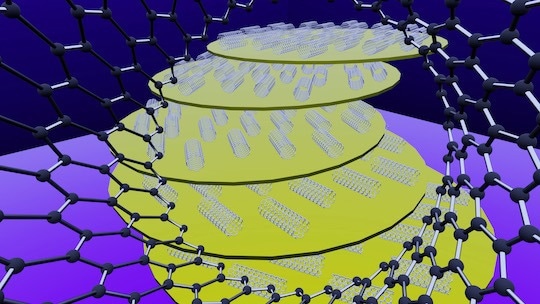Chiral materials interact with light in extremely precise ways, which can be used to create better displays, sensors, and more powerful gadgets. However, successfully creating features like the chirality at scale remains a serious difficulty in nanotechnology.
 Graphic illustration of carbon nanotubes. Image Credit: acques Doumani/Rice University
Graphic illustration of carbon nanotubes. Image Credit: acques Doumani/Rice University
Rice University scientists in Junichiro Kono’s team have found two methods for fabricating wafer-scale synthetic chiral carbon nanotube (CNT) assemblies from achiral mixtures. According to a study published in Nature Communications, the resulting “tornado” and “twisted-and-stacked” thin films can control ellipticity, a feature of polarized light, to a degree and spectrum range previously unattainable.
These approaches have granted us the ability to deliberately and consistently introduce chirality to materials that, until now, did not exhibit this property on a macroscopic scale. Our methods yield thin, flexible films with tunable chiral properties.
Jacques Doumani, Graduate Student, Rice University
CNTs, which are hollow cylindrical structures comprised of carbon atoms, have exceptional electrical, mechanical, thermal, and optical capabilities. A single-wall carbon nanotube has a diameter 100,000 times smaller than a single human hair.
The issue is that most methods for producing CNTs in larger quantities—which are required for a variety of applications—usually result in assemblies of heterogeneous, disordered nanotubes. The general performance of a material is reduced by such random structures.
The capacity to produce films in sufficient quantities with identical diameters and orientations of nanotubes might spur innovation in a wide variety of fields, including energy and medicinal applications as well as information systems.
In prior research, we showed that our vacuum filtration technique can achieve nearly perfect alignment of carbon nanotubes at significant scales. This research allows us to take that work in an exciting new direction by introducing chirality.
Junichiro Kono, Study Principal Investigator, Karl F. Hasselmann Professor in Engineering, Rice University
The finding that motion might impart a chiral twist on an ordered CNT structure arose totally by coincidence.
Doumani added, “It was, quite literally, an unexpected twist.”
He described how a shaky pump on the same table as the vacuum filtration system generated unexpected vibrations that spun the layer of aligned CNTs into a tornado-like spiral.
He further stated, “These vibrations had a profound impact on the architecture of the assembled carbon nanotubes, prompting us to explore and refine this newfound phenomenon further. This chance discovery allowed us to recognize that we can design carbon nanotube architectures with desired characteristics by adjusting rotation angles and shaking conditions.”
Kono compared the CNT assemblies’ chiral symmetry to a “work of art.”
Kono added, “I am particularly proud of Jacques for pursuing the discovery that we can combine carbon nanotube filtration and shaking to tune the characteristics of these wafer-scale films.”
The second approach included stacking highly aligned CNT films at an angle by regulating the number of layers and twisting angles.
“We achieved a remarkable milestone in the deep ultraviolet range, where we set a new record for ellipticity. What’s more, compared to competitors in this space, our technique is very simple to set up. We don’t need a complex system to make these films,” Doumani further added.
The methods can be used to create materials for novel optoelectronic devices including LEDs, lasers, solar cells, and photodetectors. It is also a configuration that might be utilized to create wafer-scale chiral films with additional nanomaterials like boron nitride nanotubes and tungsten diselenide nanotubes.
Doumani further stated, “This discovery holds promise for various applications. n pharmaceuticals and biomedicine, it offers potential in biosensing, deep-sea imaging, and identifying useful compounds. In communication, it could enhance missile detection, secure communication channels, and bolster anti-interference capabilities. In quantum computing engineering, it paves the way for more deterministic photon-emitter coupling. We’re excited to extend this technique to other types of nanomaterials as well.”
National Science Foundation (2321366, 2235267, 2230727), the Robert A. Welch Foundation (C-1509, C-1668), the Air Force Office of Scientific Research (FA9550-22-1-0382), the Chan Zuckerberg Initiative (WU-21-357), the Department of Energy (DE-AR0001015), the Japan Society for the Promotion of Science (JP20H02573, JP21H05017, JP22H05469, JP23H00259, JPJSJRP20221202, JP22H00283), the Japan Science and Technology Agency (JPMJCR1715) and the Taiwan Yushan Fellow Program supported the study.
Journal Reference:
Doumani, J, et. al. (2023) Engineering chirality at wafer scale with ordered carbon nanotube architectures. Nature Communications. doi:10.1038/s41467-023-43199-x